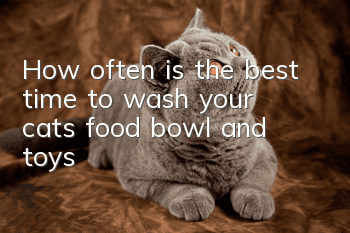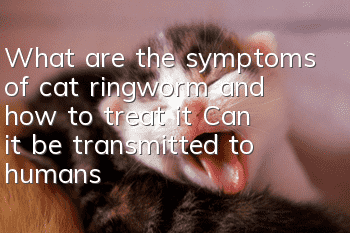How often is the best time to wash your cat’s food bowl and toys?

Every cat owner may have a question in their mind: How often should the cat’s food bowl be washed? Some scavengers themselves are lazy and think that people's bowls must be washed after every meal. Cats are pets and are not so demanding. How often should they be washed? Many people may have this doubt. So today I, the editor of Cat Love Network, will share it with you. Many cat owners may not have thought about the food bowls and water bowls where cat owners eat and drink every day. If you don't wash it for 4-5 days, there will be as many bacteria as the kitchen sink or rag.
1. How often do most people clean their pet bowls nowadays?
In fact, only 33.57% of owners can clean the food bowl once a day. The most common frequency is to clean once every 2-3 days, but there are many people who only clean once every 3 days or more than once a week. However, this data is already very good compared to the data of American owners. In 2015, a pet website conducted an anonymous survey of American pet owners. The results showed that more than 60% of pet owners clean their pet bowls once every three days. There are also 10% of pet owners who do not clean their pet bowls regularly.
2. Is this cleaning frequency enough?
Obviously not enough. In 2011, NSF (National Sanitation Foundation) conducted comprehensive inspections of 30 homes to measure bacterial contamination levels. Pet bowls and pet toys were among the top ten germiest places listed. A large number of MRSA, Pasteurella multocida, and multiple Corynebacterium species were detected on pet bowls and toys, and the amounts of these bacteria far exceeded normal levels.
Part of these bacteria come from the environment, and part of them come from the pet's mouth. They attach to food bowls and toys with saliva when eating and playing. These bacteria proliferate on pet food bowls and toys. Especially water basins and food basins have a humid environment and a lot of food residue. If they are not cleaned regularly, they are a paradise for bacteria.
3. Are there differences between rice bowls made of different materials?
Hartpury University (Hartpury, a British university) has conducted research. Bowls of three different materials: plastic, stainless steel and ceramic were tested for the amount of bacteria forming over 14 days. As expected, the number of bacteria in plastic bowls > ceramic bowls > stainless steel bowls on day 14. But surprisingly, ceramic bowls contained the most harmful bacteria, including MRSA (methicillin-resistant Staphylococcus aureus, which is highly toxic) and salmonella. If you have a choice, you should give priority to food-grade stainless steel bowls.
4. How long should it take to clean up?What about pet bowls and pet toys?
In fact, the FDA and many veterinary websites recommend that your pet’s food bowls and water bowls should be treated like you treat your own tableware: wash them once a day, and not just rinse with water, but thoroughly with a brush and detergent. . In addition to daily cleaning, according to NSF recommendations, disinfection should be carried out once a week. Use a 1:50 bleach solution to soak food bowls and water bowls for more than one minute, then rinse them thoroughly (you will be poisoned if you do not rinse them thoroughly), and dry them Dry it before feeding it to the cat. This method is also suitable for food bowls and water bowls that have not been cleaned for a long time.
According to NSF recommendations, for cat toys, washable plush toys and cat litter boxes should be cleaned at least monthly; hard-surface toys that are inconvenient to clean should be wiped with bleach once a month and rinsed thoroughly and dried. For cats, toys that cannot be washed or wiped easily, such as cat teasers and other toys, should also be sterilized in the sun regularly.
- Why do cats become less affectionate the more we keep them?
- What are the causes of dystocia in cats?
- What should I do if my cat is malnourished? How to improve it?
- How old is a cat in one month? How old is a cat in one month?
- Cat’s reaction after eating catnip
- What is the average lifespan of a cat? How old is a cat compared to a human?
- What to do if your cat has ear mites? Ear mites are contagious
- Why do cats like to poop with their owners?
- What causes patches of hair loss on kittens?
- Cat pregnancy precautions



